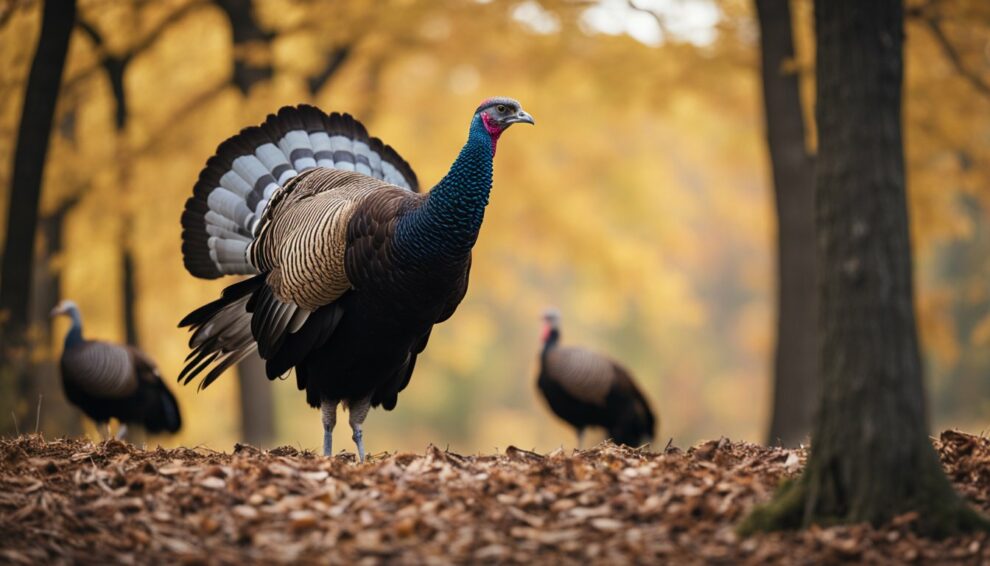Wild turkeys boast a sophisticated social system that’s every bit as organized and dynamic as a bustling city.
Within their flocks, turkeys maintain a clear pecking order that dictates not just who gets first dibs at lunch, but also who struts around with the most swagger.
Imagine a school playground where every bird knows exactly who they can hang out with, whom they should look up to, and who should be avoiding them.
It’s not just about size or strength; a turkey’s place in the social hierarchy can shape its daily habits and even influence its survival.

These birds often gather in groups, and if you watch them, you’ll see that just like in our own communities, each turkey has a role to play.
There are leaders, followers, and those that prefer to hang back and watch from the sidelines.
Adult males, known as gobblers, might puff up and put on flashy displays, but it’s not just for show.
These elaborate performances play a crucial part in their social structure, helping them to secure their status and find a mate.
While females, or hens, might seem less showy, they’re busy looking out for their young and making sure their brood stays safe.
The surprising thing is, the social life of a turkey is more than a matter of feathers; they recognize each other and have lasting relationships.
Can you imagine identifying each turkey friend by their gobbles and feathers?
What’s truly amazing is that turkeys remember these social ties, forming complex networks that are as intricate as the friendships and rivalries we find in our human lives.
The Life and Times of Wild Turkeys
Wild turkeys, known scientifically as Meleagris gallopavo, are more than just a symbol of Thanksgiving.
These birds lead intricate lives in their natural habitats, displaying a variety of physical traits that signify their unique place in the bird world.
They’re not just roaming the forests and fields; they’re a part of a complex ecosystem that relies on their presence.
Habitat and Distribution
Wild turkeys thrive across North America, calling the diverse landscapes from the eastern forests to the open grasslands of the United States their home.
These birds are adaptable, occupying a range of habitats that offer them the rich resources needed to survive and reproduce.
Conservation efforts have helped their populations rebound from near extinction in the past century, showcasing a successful story of wildlife management and research.
Physical Characteristics
Curious as to what they look like? Picture a bird standing as tall as a three-year-old child, with powerful legs and a grand tail!
Wild turkeys are immediately recognizable by their impressive size, distinctive plumage, and the iconic wattle that adorns their neck.
The feathers—depending on the subspecies—can shimmer with an array of colors like iridescent greens, coppers, and bronzes, making them quite the sight when they catch the sunlight.
The variations in their appearance tell a tale of adaptation to different environments across North America.
Social Dynamics and Behavior

Wild turkeys are known for their intricate social structures, which seem intricately woven into the fabric of their daily lives like the threads of a tapestry.
Their interactions within flocks reveal a world of pecking orders, mating displays, and the raising of their young, each shedding light on their success as a species.
Pecking Order and Dominance
The social structure of wild turkeys is firmly rooted in a hierarchy known as the pecking order.
Males establish dominance through impressive displays of gobbling and strutting, fanning out their tail feathers to showcase strength and vitality.
Dominant males, or alpha turkeys, claim the right to strut vividly in spring, signaling both social status and breeding potential.
Females, while less showy in their demeanor, also partake in this social order, determining flock leadership and access to resources through subtle social cues.
Mating Rituals and Breeding
Have you ever witnessed a male turkey puffing up and spreading its feathers like an enormous fan?
That’s the male turkey’s way of showing off – a traditional form of courtship that occurs primarily in the spring.
Vocalizations, such as the iconic gobble, resonate through the woods, acting as love songs that attract females and warn rival males.
Breeding opportunities are reserved mostly for dominant males.
Female turkeys, on the other hand, prepare nests on the ground, where they lay eggs and exemplify parental care, incubating the eggs until they hatch.
Raising the Next Generation
Once the eggs hatch, the mother leads her chicks, known as poults, on a journey through the forest to forage for food.
These family units are lessons in survival and socialization, with the mother teaching her young about the world around them.
While the males play no role in rearing the chicks, they continue to protect the flock and maintain the social order that plays such a crucial role in the lives of wild turkeys.
Wild turkeys exhibit a remarkable layering of family and social dynamics, where every gobble and stride has a purpose, knitting together their communal fabric one thread at a time.
Interactions with the Environment

Understanding how wild turkeys engage with their environments helps us see the intricate role they play in the ecosystem.
They interact with their habitat in unique ways, from the food they eat to the pressure they face from predators.
Foraging and Diet
Wild turkeys exhibit diverse foraging behavior, often depending on seasonal availability.
Their diet consists largely of nuts and seeds, with a special liking for acorns and berries that flourish in forested areas.
In the spring and summer, these birds frequently wander through riparian zones—the interface between land and a river or stream—snatching up insects and grasses, which provide a protein-rich supplement to their diet.
This eclectic consumption of food makes them an integral part of the ecosystem, helping with the dispersal of seeds and control of insect populations.
Did you know that during autumn, wild turkeys tend to eat more hard mast?
This includes not just acorns but also hickory nuts and beechnuts.
As expert foragers, they scratch the forest floor with their strong legs, uncovering hidden food treasures that comprise their hearty diet.
Predation and Threats
While wild turkeys have keen vision that helps them avoid danger, they still face threats from a range of predators such as foxes, coyotes, hawks, and owls.
Fledgling turkeys are particularly vulnerable, often falling prey to snakes and raccoons.
Beyond natural predators, hunting poses a significant risk, although regulated hunting can help maintain balanced populations and prevent overgrazing of their habitats.
Habitat loss through deforestation and habitat destruction can severely affect wild turkey populations by removing their food sources and nesting areas.
Disease can also spread more rapidly when turkeys are confined to smaller spaces.
Conservation efforts are therefore important to manage and protect wild turkey habitats, ensuring these birds continue to thrive in their natural setting.
Ever thought about how a turkey might feel, waking up to a forest that has changed overnight?
It’s up to humans to work on conservation to keep those forests just as bustling with life as a turkey would remember.
Conservation Efforts and Human Impact

When we think about wild turkeys, images of Thanksgiving might flutter through our minds, but there’s much more to these birds than just a holiday.
They were once on the brink of disappearing from North America.
Wildlife Management and Restoration
Humans have played a critical role in the comeback story of wild turkeys.
From a low point where their numbers dipped alarmingly due to overhunting and habitat destruction, wildlife managers stepped in.
They introduced robust conservation programs that included habitat restoration and regulated hunting practices to strike a balance.
For instance, by the late 1990s and early 2000s, these efforts saw wild turkey populations soar to between 6 and 7 million birds.
Restoration techniques, like the ingenious use of rocket nets, have been pivotal in relocating wild turkeys to areas they once roamed freely.
Have you ever seen a net flying through the air? That’s wildlife managers at work!
And thanks to educational nonprofit partners like the Great Smoky Mountains Association, people can learn about these efforts at smokiesinformation.org.
Cultural Significance
Wild turkeys are not only important from a conservation standpoint but have woven their way into the cultural tapestry as well.
They serve as game birds cherished by hunters, especially during the Thanksgiving holiday, which accents their cultural prominence.
However, the Great Smoky Mountains National Park plays a custodial role in preserving their habitat and preventing them from becoming too habituated to human presence.
In managing parks and ensuring sustainable populations, wildlife agencies juggle the turkeys’ health and the public’s fascination.
By doing so, they not only protect the turkeys but also maintain the rich heritage that these majestic birds symbolize.
Imagine a forest without the sight of turkeys strutting.
Thanks to these ongoing efforts by humans, it’s a sight we can continue to enjoy and cherish.
Frequently Asked Questions

Wild turkeys navigate a complex social world, with a pecking order that determines everything from feeding positions to roosting spots.
Understanding their social structure gives insight into how these birds maintain order and survive in the wild.
How do wild turkeys establish their pecking order?
Wild turkeys establish their pecking order through displays of dominance and submission.
The more dominant birds strut, puff up, and fan their tail feathers to assert power.
Physical confrontations, though rare, can occur until a hierarchy is established.
Can you describe the different roles within a turkey flock?
Within a turkey flock, the dominant males, or toms, lead the group and protect it from predators.
Hens have their own hierarchy, often led by the oldest female. They are responsible for choosing nesting sites and teaching the young.
How do wild turkey groups interact with each other?
Groups of wild turkeys, known as flocks, interact mainly during foraging and roosting.
While they generally stick to their own flock, different flocks may come together in areas with abundant resources, displaying social gestures to maintain the order.
In what ways do juvenile turkeys fit into the social dynamics of their flock?
Juvenile turkeys learn the social dynamics of the flock from their mothers.
They start off at the bottom of the pecking order and must observe and adapt to the established hierarchy, gradually finding their place as they mature.
What are the typical behaviors displayed by turkeys to maintain their social hierarchy?
Turkeys display a variety of behaviors such as strutting, gobbling, and puffing up to maintain their social hierarchy.
These displays communicate to other turkeys their status and help to reinforce the pecking order without resorting to conflict.
How does the season affect the social structure of wild turkey populations?
The social structure of wild turkey populations changes with the seasons. In spring, males display to attract females and establish breeding rights.
In the fall, both males and females form separate flocks that are less concerned with breeding and more focused on foraging and survival.









